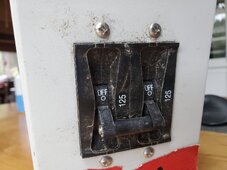hogback
New Member
I inherited some surplus Carling DC 125A breakers that I'd like to use between my bms and inverter/charger. Some of the breakers came with some scrap/cut wire with lugs attached, which were attached to the breaker studs. The studs have two nuts and two washers each (plus one star washer against the plastic breaker housing), and in the case of the previous user, the wire lugs were sandwiched like this: starwasher-nut-washer-lug-washer-nut. I'm not sure how I should properly torque my lugs with this stud mounting system. It seems like if you torque the outer nut with respect to the inner nut, the whole connection must be relying on current running through the threads, which doesn't seem right, and is certainly never recommended for battery terminals. If you remove all the nuts/washers, the studs just disappear into the plastic, and there is no terminal plate/metal to secure against. The Carling datasheet has no instructions. Has anyone else used stud connected breakers like this before? Any tips? Thanks!




